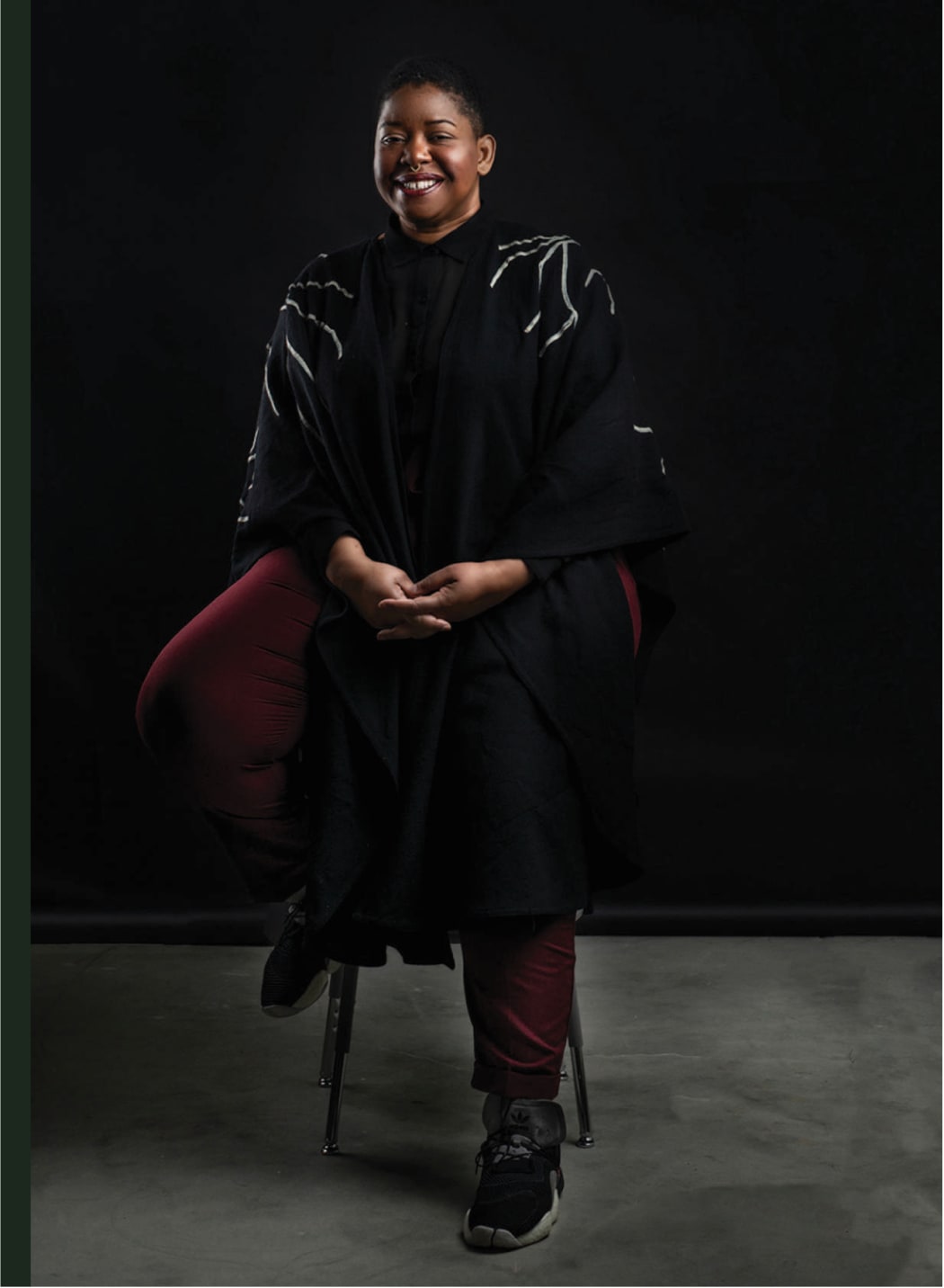
We always like to start the In Conversation series at the beginning of the artistic career. Can you recall what sparked the start of your artistic journey, and have you always felt a creative drive and known you wanted to be an artist, or was there a defining moment that led you to pursue your artistic career?
I wouldn't say I started creative. I was always into math and science. And I always liked trying to figure things out. My artistic journey really began when I studied architecture. A program so intense, we used to call ‘the meat grinder’. The curriculum could be overwhelming, sometimes seven classes per term, balancing design with math and science. As part of this program, I took a drawing class, as a way to relieve stress. The architecture building was directly across the courtyard from the art building, so I decided to also take a clay class. That was incredibly relaxing. But the real turning point came with a sculpture course.
At the same time, I was becoming disillusioned with architecture. I wanted more than to just grind through this coursework. One student suggested I look at another institution, and that’s what eventually led me to Parsons. Suddenly, I was surrounded by creative people. I had to build up technical skills I lacked, like 2D design and color theory, and that, too, was grueling. But this time, I could finally explore what I wanted whereas architecture has so many limitations. Architecture felt so restrictive. Even when you finish, creating beautiful architecture requires wealthy, visionary clients, and endless compromises. I thought, “I’ll do this undergrad, and if I want to, I can always go back for a graduate degree in architecture.” But after I finished my undergrad, I realized I wanted to continue into graduate work in studio art and art history. In the end, it felt less like I chose art—art chose me, and I fully committed.
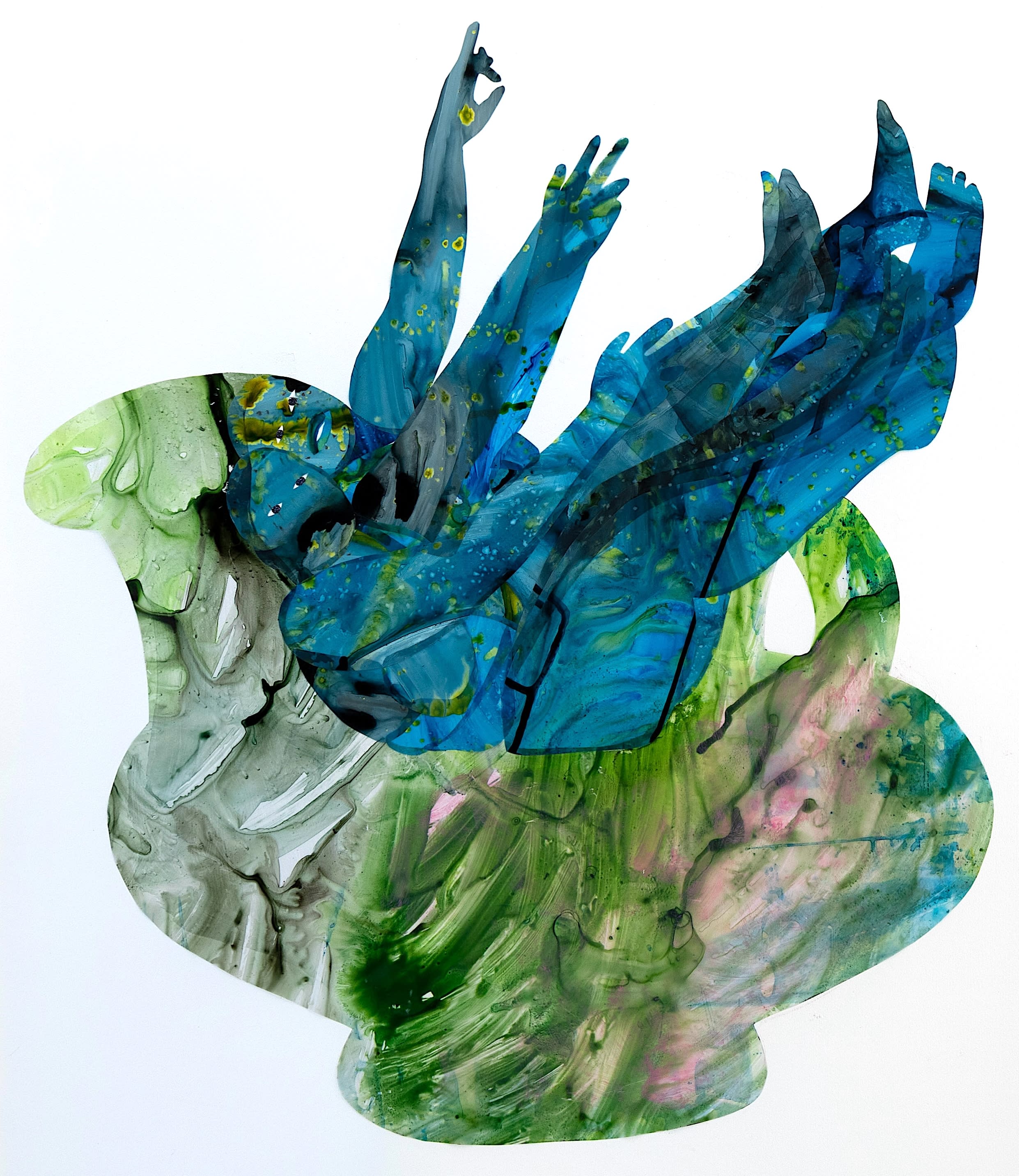
M. Florine Démosthène, Majik, 2024-25, Collage on paper (mylar, acrylic and glitter), 99 × 69 cm (39 × 27 in), photo: Alberto Stievanin (detail).
You were raised between New York and Port au Prince in Haiti. Can you tell me a bit about that? What was that like? I imagine them to be two quite different worlds.
Haiti today is not the Haiti that I grew up in. They’re like two very different countries now, especially to Haitians who came to the US in the late 60s, like my parents. I came to the US young, so I adjusted between the worlds fairly naturally.
The real stark difference that my older sister and I experienced, is that we were left on our own a lot, and we weren't used to that. In the US, we went to school by ourselves and came home by ourselves. In Haiti that was unheard of. There was always someone there, my grandmother for example, who took us all to school every day. In the US, it's pretty much just your parents whereas in Haiti, it’s not. It's your whole family. That has probably had an lasting impression on me, the duality between those two.
When I moved to Ghana for example, after about six months in, I started craving apple cider. It was maddening. I didn’t even know I liked apple cider that much, but it was tied to memories of suburban New York, to the smell and the season. I couldn’t find it anywhere so I started trying to figure out how I could make some myself. If and how I could use South African apples to revive this childhood memory. Growing up, I constantly searched for that same type of echoes of experiences that I had had in Haiti: a particular smell, a particular taste of something. In a way, that has been the greatest influence. Searching for and wanting to relive these experiences. Documenting experiences that can never really be documented.
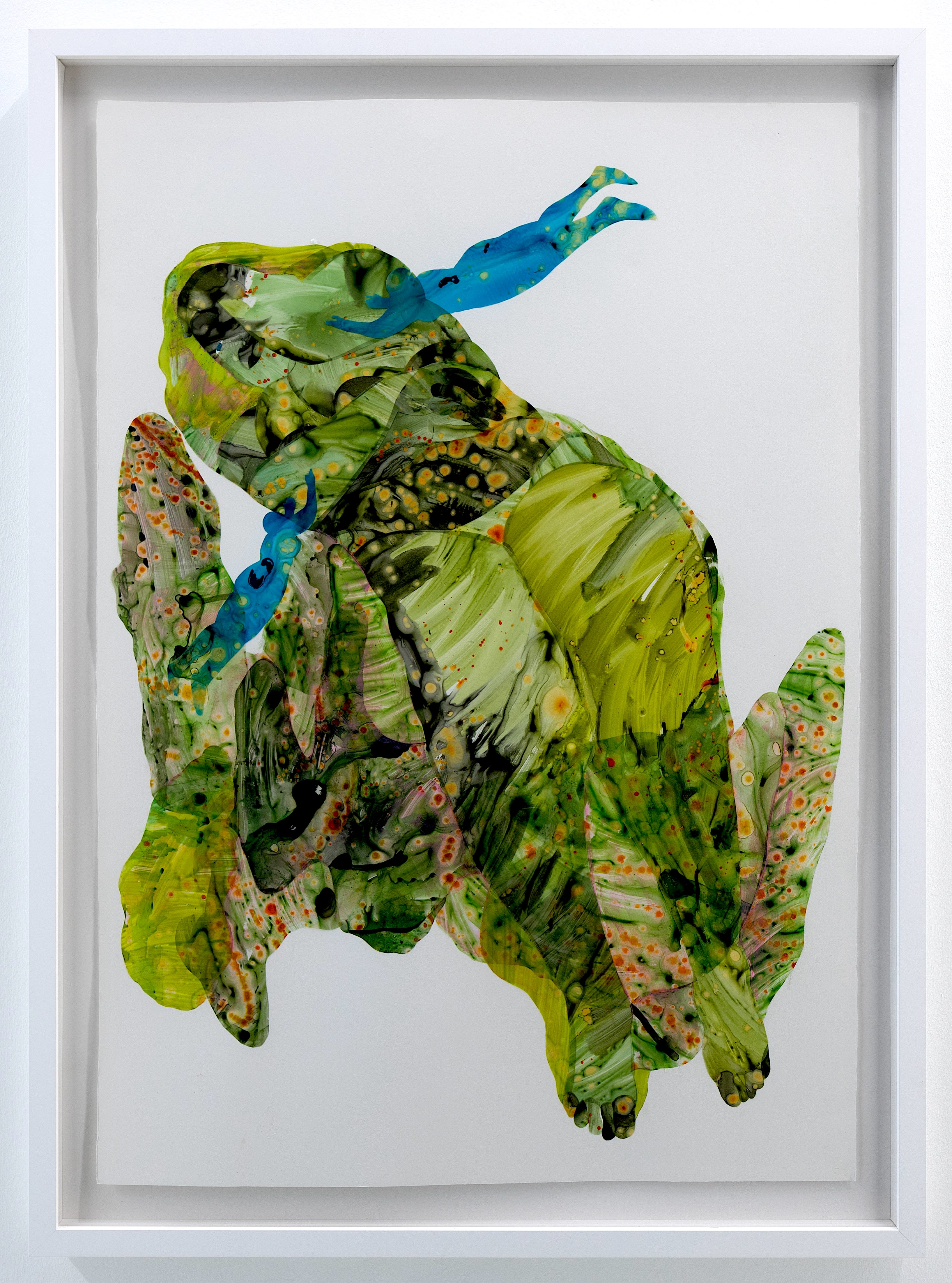
M. Florine Démosthène, Mond Nan Mitan (In Between World), 2024-25, Collage on paper (mylar, acrylic and glitter), 99 × 69 cm (39 × 27 in), photo: Alberto Stievanin.
In how far are the technique of collaging as well as the repetition and over imposing of figures in your work a representation of these two different worlds you grew up in and in that sense a representation of two different versions of self, shaped by place, memory or experience?
Well, I borrow from multiple traditions. Haiti has its very own artistic traditions, an own canon of work and a very complex spiritual system. This has always been part of my personal experience. The collage though came out of a necessity, simply running out of materials. When I lived in Ghana I could not import materials I needed so I had to use whatever else I had. And that's how collage came into play. It was a need I had to fulfill. But also, it was a technique that I learned very early on at Parsons, looking at Matisse cutouts, Romare Bearden collages, or works by Jacob Lawrence, simplifying the form and the two-dimensional picture plane. So when this material crisis came up in Ghana, collaging was the solution to the problem. In the end, the collage process became a much faster and much more direct way of working than painting. When painting or drawing, I sometimes felt constrained. With collage, I didn’t know exactly what would happen. I just set aside time and created, letting the process surprise me. It became the best way to incorporate spirituality, tradition, and emotion into my work, expressing complex ideas in simplified forms.
In these collages and through your work, there's this female figure that keeps reappearing. What does she stand for? What does her body represent?
This figure is basically myself. I started using myself as a model because I was available. Within less than a year of working that way though, it was no longer about me. It wasn't my narrative. Even though a lot of people feel like it's me speaking of a personal journey, it is actually more of a way of communicating ideas. I knew I wanted to use a figure to do it, but I didn't want it to be highly rendered or very stiff. I wanted it to be something anyone could enter into. The figure became a vehicle of expressing ideas which I was trying to figure out. And as my work progressed, I began dropping the background. I used to work with constructed foregrounds, middle grounds, and backgrounds, and there was a lot of communication between the spaces the figure occupied and the figure itself. But the minute I dropped the background and replaced it with this sort of void it became something completely else, because the only thing a viewer would focus on now was the figure. So the figure had to embody everything that I wanted to say.
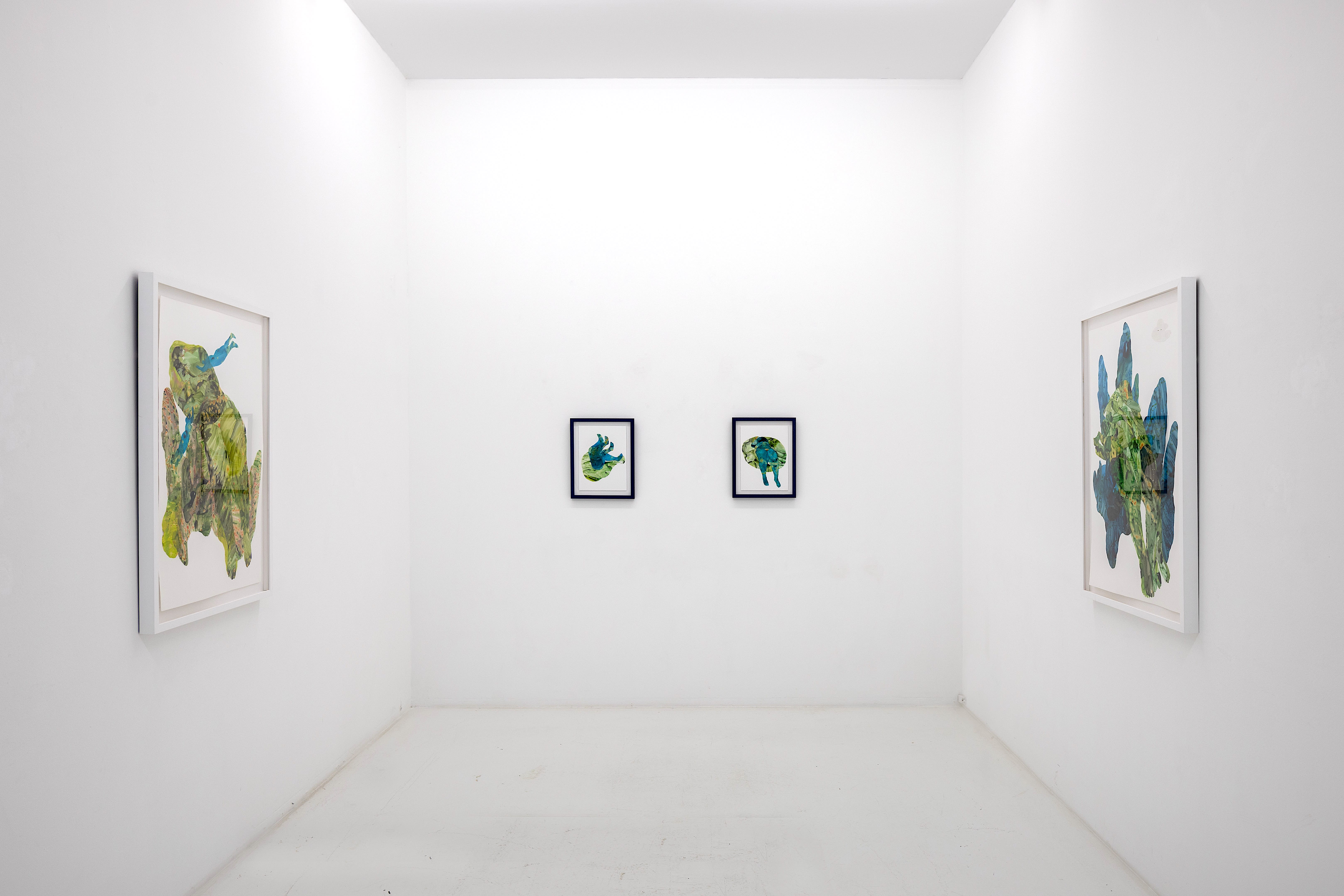
Installation view of Zansèt Yo, 2025, BODE Berlin, photo: Alberto Stievanin.
Is this relationship between the figure and its constructed surroundings, and finally the decision to avoid any architectural set-up of pictorial planes tracing back to your architecture studies? Would you say that the further you moved away from the architecture, the emptier your pictures became?
Maybe, I am not entirely sure. I think it's more of a simplification of architecture. One of my favorite periods of architecture is modernism. Working with the essentials: wood, metal, glass or steel. My pieces are mostly on paper, which to me is a very essential material and which is a statement on its own as works on canvas tend to get paid so much more attention. But there is this tactility with paper. Especially when collaging, it’s paper upon paper upon paper, constructing materiality.
But finally, the decision to empty the surroundings was less about architecture, and more guided along aesthetic preferences and, again, can be traced back to material shortages. When I ran out of materials in Ghana preparing for my 2018 solo show, I started to build atmospheric, cloudy backgrounds the figures would be floating in. When I realized I still didn’t have enough material painted the backgrounds. The figures started to gain this floating nature, but you were still able to anchor them to in the nebulous space. Without the background I quickly realized I had to emphasize how I posed the figure to really help the space be anchored. The figures became more vulnerable because they weren't anchored into anything.
How does this process of placing them on the paper plane work? How do you find their position and the movements they make? Is it? Do you move them around, or do you have a shape in mind before you even start?
Usually I work in series. I start with very simple sketches, then I organize a photo shoot. After that, I figure everything out in Photoshop which has really helped me. Before, I used to cut everything by hand and try to fit it together, but it never quite worked. Now Photoshop acts as the final sketch. Once I have a printout that feels right, I move on to cutting and pasting. I still make adjustments in the process, but the Photoshop collage gives me a clear guide: This element goes here, that one goes there. Without it, a single piece could take me weeks to resolve.
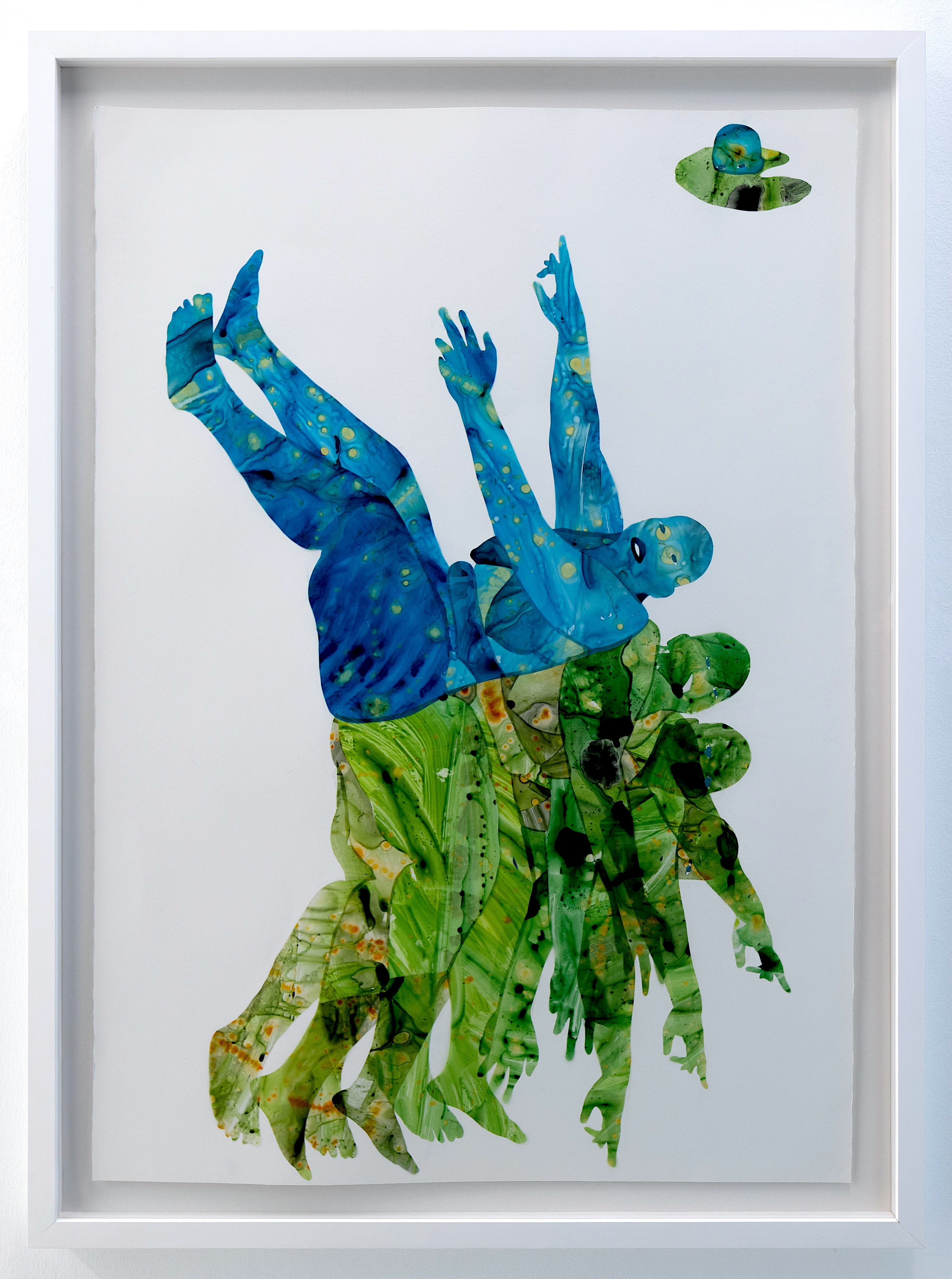
M. Florine Démosthène, Madichon (Haitian Karma), 2024-25, Collage on paper (mylar, acrylic and glitter), 99 × 69 cm (39 × 27 in), photo: Alberto Stievanin.
And how do your titles factor into your work storytelling, and do they often precede the visual work, or do they follow as reflections?
Usually they proceed. I keep a running list of titles. For a new series, I’ll select the ones I want to use, then set them aside in a sketchbook and sometimes forget about them while making the works. Later, I’ll align the finished pieces with the titles.
What are three things you couldn't live and work without in the studio?
Number one is tea. I always have tea in the studio.
Any particular kind?
I have a ridiculous amount of tea at the studio. Really high-quality tea, depending on the season, green or black. Good tea is essential. The second thing is scissors. I have far too many pairs, but I keep collecting them, especially very fine ones. And the third is lighting. My desk lamp is indispensable. When I travel to make work, those three—tea, scissors, and a lamp—are the first things I think about. Everything else I can improvise.
That makes sense. Earlier you mentioned some artistic influences. Who would you name as your main ones? And beyond visual art, are there works of literature or music that have shaped your practice?
In terms of artists, definitely Kerry James Marshall. I admire artists with long careers, 25 years or more, because you can see how their work evolves. Marshall’s ability to move between media is inspiring: from comics to large-scale paintings, in black and white, in color, with or without text. Another important influence is the Cuban artist Belkis Ayón. Her work engages deeply with spirituality, particularly Caribbean traditions. The way she creates figures that hover between ancestors and living beings is fascinating and very powerful to me.
As for literature, I read widely: essays, novels, anything. Often a single passage will spark an idea, which I then expand and stretch into something new. Music is equally important. I’m an audiophile, so I listen constantly. I can’t point to one musician or genre, there are simply too many, but sound is always part of my creative environment.
We’re already at the last question. And this could be one of the artists you just mentioned, or another one, if you could pick one artist, dead or alive to show your work alongside theirs in a duo exhibition. Who would you like? Would you like?
Definitely Belkis Ayón. Our works would resonate with each other in a very interesting way.
Interview conducted by Maren Möhlenkamp